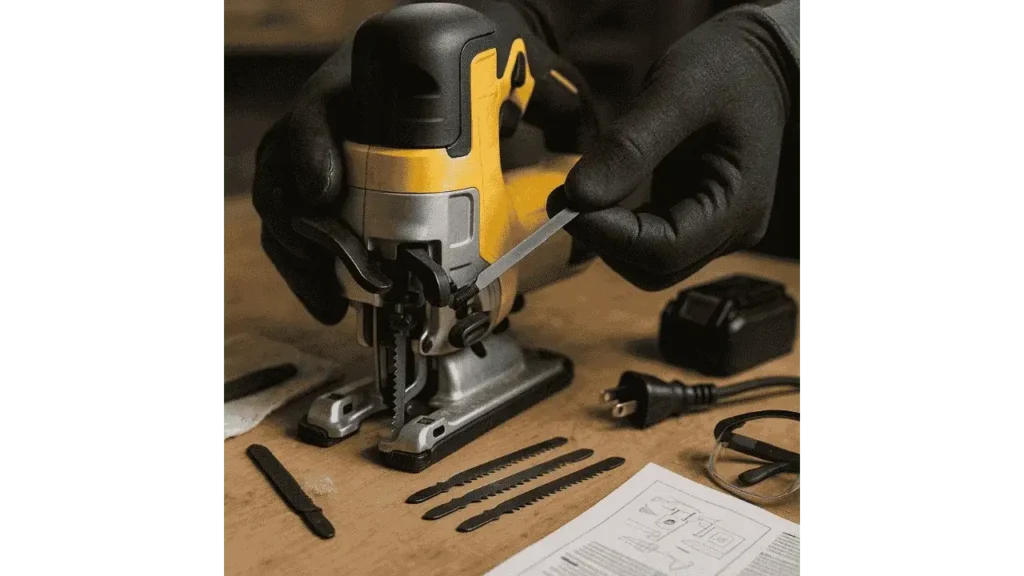If you own a jigsaw, sooner or later you’ll need to replace the blade. From my own experience, nothing throws off a project faster than trying to finish a cut with a dull or bent blade, it not only slows you down but also makes the work sloppy. Knowing how to change a jigsaw blade is essential not just for safety, but also for getting clean and efficient cuts every time. A dull or damaged blade makes your work harder and the results messier. Let’s learn why blade changes are necessary, the types of blades and clamp systems you’ll encounter, and the safe, simple steps to swap a blade correctly.

Why Do You Need to Change a Jigsaw Blade?
“A fresh blade is the difference between struggling through a cut and letting the saw glide like it’s meant to.” – Roy Underhill, Traditional Woodworker
Blades don’t last forever. A bent or broken blade will wander off your cut line and leave behind rough edges. A dull blade requires more effort, causes tearing, and reduces your control over the tool. Different materials, wood, metal, or plastic, also demand specific blade types for best results. Swapping blades at the right time keeps your work accurate and safe.
Understanding Jigsaw Blade Types & Clamp Mechanisms
Blade Types – T-Shank vs. U-Shank
Most modern jigsaws use T-shank blades, which lock securely into place and allow for easy, tool-free changes. U-shank blades are found on older models and require a tool, such as an Allen key or screwdriver, to secure them.
“Always match the blade system to your tool. Using the right shank style ensures proper fit, stability, and safety.” – Norm Abram, Master Carpenter
Clamp Systems for Blade Retention
Different jigsaws use different clamping systems to hold the blade. Quick-release or quick-change clamps use a lever or button that allows you to swap blades quickly without tools. Keyless clamps use a twist knob or sleeve to tighten the blade by hand. Screw clamps, usually found on older or budget jigsaws, require an Allen key or screwdriver to secure the blade. Each system has its own feel, but all serve the same purpose: to keep the blade locked in place while you cut.
Step-by-Step Guide: How to Change a Jigsaw Blade?
Step 1: Safety First
Unplug the jigsaw or remove its battery before you do anything. This prevents accidental startup. Wear protective gloves to avoid cuts from sharp teeth or slipping tools.
Step 2: Access the Blade Area
Flip the tool over to expose the blade area. If there are any protective covers or guide bars in the way, remove them carefully. Some models require loosening screws, while others open without tools.
Step 3: Remove the Old Blade
For quick-release clamps, activate the lever or press the release button to eject the blade. If you’re using a screw clamp system, loosen it with the correct tool until the blade slides out.
“Never yank a stuck blade. Loosen the clamp properly or you risk bending the mechanism and damaging your saw.” – Steve Ramsey, Woodworking Educator
Step 4: Insert the New Blade
Check the orientation: the blade teeth should point forward, away from the body of the jigsaw. Slide the blade fully into the clamp until it clicks or locks into place. Activate the clamp lever or tighten screws to secure it. Give the blade a gentle tug to confirm it’s locked in correctly.
Step 5: Reassemble and Test
Replace any covers or components you removed earlier. Reconnect power by plugging in the tool or reinserting the battery. Run the jigsaw briefly without cutting anything to make sure the blade stays stable and aligned.
Final Takeaways
“Changing blades regularly is just as important as learning to cut properly. A sharp, secure blade keeps both you and your project safe.” – Tom Silva, General Contractor
When it comes to jigsaws, the blade is everything. Keeping it sharp and knowing how to change it correctly means your cuts will be cleaner, your tool will run more smoothly, and your projects will take less effort overall. From my own workshop experience, I’ve learned that a quick blade change can save hours of frustration and prevent costly mistakes. Remember the essentials: match the blade to your material, understand your clamp system, and always prioritize safety when swapping blades.
Now that you know how to change a jigsaw blade safely and correctly, you can approach every project with greater confidence and precision, whether you’re tackling wood, metal, or other materials.
- How to Cut a Straight Line with a Jigsaw? - October 31, 2025
- How to Cut a Circle with a Jigsaw? - October 31, 2025
- Can You Cut Acrylic with a Jigsaw? - October 31, 2025
